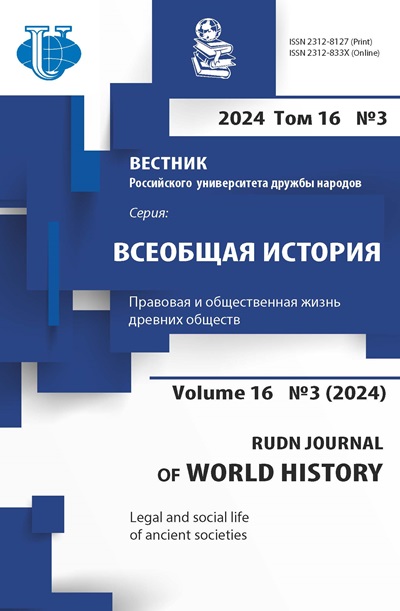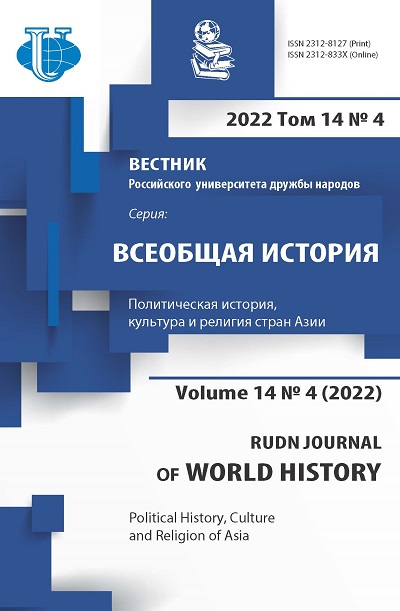Потенциальная стратегия Японии по обеспечению национальной безопасности
- Авторы: Тоёда Т.1, Васенёва Е.2, Такахама Р.1
-
Учреждения:
- Международный университет Акита
- Национальный исследовательский университет Высшая школа экономики
- Выпуск: Том 14, № 4 (2022): Политическая история, культура и религия стран Азии
- Страницы: 410-426
- Раздел: Современный мир
- URL: https://journals.rudn.ru/world-history/article/view/33149
- DOI: https://doi.org/10.22363/2312-8127-2022-14-4-410-426
Цитировать
Полный текст
Аннотация
Исследуются стратегические опции политики в области обеспечения национальной безопасности Японии на современном этапе, которые целесообразно рассмотреть в краткосрочной, среднесрочной и долгосрочной перспективе соответственно. Цель исследования - анализ стратегических планов внешней и оборонной политики Японии в обозримом будущем.Всеобъемлющий обзор японской политики в области обеспечения безопасности на современном этапе опирается на сравнительные методы и case study для анализа внешнеполитических целей Японии в рамках отношений Токио с наиболее важными партнерами в Азиатско-Тихоокеанском регионе: США, Китаем, Россией, АСЕАН и Тайванем. Рассматривая возникновение и дальнейшее развитие Четырехстороннего оборонного формата (QUAD), авторы подчеркивают отсутствие в нем членов АСЕАН и нерешительность Индии в вопросе институционализации группировки. Анализ российско-японских отношений акцентирует внимание на общих интересах в сотрудничестве в сфере безопасности, а также на его ограничениях. По результатам анализа авторы приходят к выводу, что в краткосрочной перспективе расширение японо-американского альянса в Индо-Тихоокеанском регионе является наиболее вероятным вариантом. Однако без привлечения стран АСЕАН стратегия Свободного и открытого Индо-Тихоокеанского региона (FOIP) может лишь расширить участие Австралии и Индии в рамках существующего альянса Япония-США. В среднесрочной перспективе сотрудничество с Россией может быть, но с некоторыми серьезными ограничениями, географически естественным вариантом. В долгосрочной перспективе Японии, возможно, придется столкнуться с вызовом поиска места в китаецетричном международном порядке в Восточной Азии. Авторы делают вывод о неизбежности относительного снижения влияния США в Восточной Азии в ближайшие десятилетия, в связи с чем Япония должна скорректировать или даже пересмотреть свою политику безопасности.
Ключевые слова
Об авторах
Тэцуя Тоёда
Международный университет Акита
Email: toyoda@aiu.ac.jp
ORCID iD: 0000-0001-6309-3679
директор Института азиатских исследований и регионального сотрудничества
010-1292, Юва, Акита-Сити, ЯпонияЕкатерина Васенёва
Национальный исследовательский университет Высшая школа экономики
Автор, ответственный за переписку.
Email: eavasenyova@edu.hse.ru
ORCID iD: 0000-0002-7693-0736
бакалавр азиатских исследований, Национальный исследовательский университет - Высшая школа экономики ВШЭ; стажер-исследователь, Центр комплексных европейских и международных исследований (Россия).
119017, Россия, Москва, ул. Малая Ордынка, 17Рё Такахама
Международный университет Акита
Email: b1801487@gl.aiu.ac.jp
студент 010-1292, Юва, Акита-Сити, Япония
Список литературы
- Data. The World Bank. Available from: https://data.worldbank.org/indicator/ [GDP (current US$)] [Accessed 17.09.2021].
- China’s National Defense in the New Era. State Council Information Office, July 2019. Available from: http://english.www.gov.cn/archive/whitepaper. [Accessed 11.09.2021].
- Green M., Hicks K., Cooper Z. [et.al.] Countering Coercion in Maritime Asia. CSIS. Available from: https://amti.csis.org/counter-co-scarborough-standoff/ [Accessed 11.09.2021].
- Carbis Bay G7 Summit Communiqué. G7 UK Website. Available from: https://www.g7uk.org/, paragraph 60 [accessed 11.09.2021].
- Diplomatic Bluebook 2021. Ministry of Foreign Affairs of Japan. Available from: https://www.mofa.go.jp/policy/other/bluebook/2021/pdf/pdfs/2021_all.pdf [Accessed 16.02.2022].
- Global Economic Prospects. World Bank Group, June 2021. Available from: https://openknowledge.worldbank.org/bitstream/handle/10986/35647/9781464816659.pdf [Accessed 12.09.2021].
- Abe S. Keynote address to the Sixth Tokyo International Conference on African Development (TICAD VI). August 2016. Ministry of Foreign Affairs of Japan. Available from: https://www.mofa.go.jp/afr/af2/page4e_000496.html [Accessed 11.09.2021].
- India-Japan Joint Statement during the visit of the Prime Minister to Japan. November 2016. Ministry of External Affairs. Government of India. Available from: https://mea.gov. in/bilateral-documents.htm?dtl/27599/IndiaJapan+Joint+Statement+during+the+visit+of+P rime+Minister+to+Japan [Accessed 11.09.2021].
- National Security Strategy of the United States of America, December 2017. White House. Available from: http://www.whitehouse.gov/ [accessed 11.09.2021].
- Koga K. Japan and Southeast Asia in the Indo-Pacific. In: Kikuchi T. et.al. Implementing the Indo-Pacific: Japan’s region building initiatives. Perth USAsia Center. Available from: https://perthusasia.edu.au/events/past-conferences/defence-forum2019/2019-indo-pacific-defence-conference-videos/keynotes-and-feature-presentations/pu134-japan-book-web.aspx [Accessed 11.09.2021].
- Kawai M. “One Belt, One Road” Initiative and “Indo-Pacific” Initiative. Anti-Globalism Reconsideration: A Study of Crisis Factors Shaking the International Economic Order. “World Economic Study Group” Report. Japan Institute of International Affairs. Available from: https://www2.jiia.or.jp/pdf/research/R01_World_Economy/05-kawai.pdf (In Jap.) [Accessed 11.09.2021].
- Hosoya Y. FOIP 2.0: The Evolution of Japan’s Free and Open Indo-Pacific Strategy. AsiaPacific Review. 2019;26(1):18-28. https://doi.org/10.1080/13439006.2019.1622868
- The Trump Administration’s “Free and Open Indo-Pacific”: Issues for Congress. October 2018. Congressional Research Service. Available from: https://crsreports.congress.gov/ product/pdf/R/R45396 [Accessed 11.09.2021].
- Chairman’s statement of the 32nd ASEAN Summit, Singapore, 28 April 2018. ASEAN Secretariat. Available from: https://asean.org/storage/2018/04/Chairmans-Statement-of-the32nd-ASEAN-Summit.pdf [Accessed 14.09.2021].
- Japan-Cambodia Summit Meeting. Ministry of Foreign Affairs of Japan. Available from: https://www.mofa.go.jp/s_sa/sea1/kh/page4e_000641.html [Accessed 11.09.2021].
- Japan-Laos Summit Meeting. Ministry of Foreign Affairs of Japan. Available from: https:// www.mofa.go.jp/s_sa/sea1/la/page4e_000854.html [Accessed 11.09.2021].
- Vibhanshu S. Is Indonesia’s ‘Indo-Pacific Cooperation’ Strategy a Weak Play? PacNet #47. 16 July 2018. Available from: https://pacforum.org/publication/pacnet-47-is-indonesiasindo-pacific-cooperation-strategy-a-weak-play [Accessed 11.09.2021].
- He K., Feng, H. The Institutionalization of the Indo-Pacific: Problems and Prospects. International Affairs. 2020;96(1):149-168. https://doi.org/10.1093/ia/iiz194
- Tan S.S. Consigned to hedge: South-east Asia and America’s “Free and Open IndoPacific” Strategy. International Affairs. 2020;96(1):131-148. https://doi.org/10.1093/ ia/iiz227
- Koga K. A Diplomatic ‘New Normal’ in the Indo-Pacific Region? Comparative Connections. 2021;23(1):151-160. Available from: http://cc.pacforum.org/2021/05/a-diplomatic-newnormal-in-the-indo-pacific-region/ [Accessed 21.12.2021].
- Interim National Security Guidance. March 2021, 20-21. White House. Available from: https://www.whitehouse.gov/wp-content/uploads/2021/03/NSC-1v2.pdf [accessed 21.12.2021].
- Press Briefing, December 6, 2021. White House. Available from: https://www.whitehouse.gov/briefing-room/press-briefings/2021/12/06/press-briefing-by-press-secretary-jen-psakidecember-6-2021/ [Accessed 21.12.2021].
- Lowy Institute Poll 2021. Views on China. Lowy Institute. Available from: https://poll.lowyinstitute.org/charts/views-of-china [Accessed 21.12.2021].
- How Indians see their place in the world? Pew Research Center. Available from: https://www.pewresearch.org/global/2016/09/19/3-how-indians-see-their-place-in-the-world/ [Accessed 21.12.2021].
- Joint Leaders Statement on AUKUS, 15 September 2021. The White House. Available from: https://www.whitehouse.gov/briefing-room/statements-releases/2021/09/15/joint-leadersstatement-on-aukus/ [Accessed 21.12.2021].
- Pfluke C. A history of the Five Eyes Alliance: Possibility for reform and additions. Comparative Strategy. 2019;38(4):302-315.
- Yang M. Russia’s Regional Security Role. Watanabe K. Engaging Russia in Asia-Pacific. Japan Center for International Exchange, 1999. 320 p.
- Toloraya G. The Six Party Talks: A Russian Perspective. Asian Perspective. 2008;32(4):45-69.
- Kireeva A. The Indo-Pacific in the Strategies of the U.S. and Japan. Russia in Global Affairs. 2020;18(3):98-127.
- Japan-Russia Summit Meeting, 5 Sep 2019. Ministry of Foreign Affairs of Japan. Available from: https://www.mofa.go.jp/erp/rss/northern/page4e_001108.html [Accessed 22.12.2021].
- Glava MID Yaponii: Tokio i Moskve neobkhodimo tesno vzaimodeystvovat dlya resheniya yadernoy problemy KNDR e. (In Russ.) 23 Nov 2017. Interfax. https://www.mofa.go.jp/mofaj/files/000312397.pdf [Accessed 21.12.2021].
- Brown J. Japan’s security cooperation with Russia: neutralizing the threat of a China-Russia united front. International Affairs. 2018;94(4):861-882. https://doi.org/10.1093/ia/iiy031
- Defense of Japan of 2016. Ministry of Defense. Available from: https://warp.da.ndl.go.jp/ info:ndljp/pid/11591426/www.mod.go.jp/e/publ/w_paper/2016.html [Accessed 21.12.2021).
- Japan’s Energy Supply Situation and Basic Policy, 2015. FEPC. Available from: https:// www.fepc.or.jp/english/energy_electricity/supply_situation/ [Accessed 21.12.2021].
- Japan, 2020. EIA. Available from: https://www.eia.gov/international/analysis/country/JPN [Accessed 21.12.2021].
- Lankov A. Russia’s Waning Influence on North Korea. 21 December 2021. Carnegie Endowment for International Peace Moscow Center. Available from: https://carnegie.ru/commentary/83506 [Accessed 21.12.2021].
- Arai H. Japan-Russia Economic Relations with Emphasis on Energy Cooperation, 2016. Sasakawa Peace Foundation. Available from: https://spfusa.org/wp-content/uploads/2016/05/Sasakawa_Japan-Russia.pdf [Accessed 21.12.2021].
- Rozman G. Introduction Japan-Russia Relations under Abe-Putin: Progress and Prospects, 2016. Sasakawa Peace Foundation. Available from: https://spfusa.org/wp-content/uploads/2016/05/Sasakawa_Japan-Russia.pdf [Accessed 21.12.2021].
- 4 countries’ Joint Public Opinion Survey conducted in Japan, U.S., China, South Korea in 2015 (In Jap.) Genron. Available from: http://www.genron-npo.net/world/archives/6002.html [Accessed 21.12.2021].
- Trends in Chinese Government and Other Vessels in the Waters Surrounding the Senkaku Islands, and Japan’s Response - Records of Intrusions of Chinese Government and Other Vessels into Japan’s Territorial Sea - May 14, 2021. Ministry of Foreign Affairs of Japan. Available from: https://www.mofa.go.jp/region/page23e_000021.html [Accessed 21.12.2021].
- Japan-U.S. Joint Statement, Joint Statement, 10 February 201. Ministry of Foreign Affairs of Japan. Available from: https://www.mofa.go.jp/mofaj/files/000227768.pdf [Accessed 19.12.2021].
- Telephone Talk between Prime Minister Suga and President-elect Biden 12 November 2020. Ministry of Foreign Affairs of Japan. Available from: https://www.mofa.go.jp/na/na1/us/ page3e_001104.html [Accessed 19.12.2021].
- JSDF completed multilateral training event, ARC21 with the U.S. Navy, the U.S. Marine Corps, the Australian Navy, the French Navy, and the French Army. Ministry of Defense. Available from: https://www.mod.go.jp/msdf/sf/english/news/05/0519.html [Accessed 19.12.2021].
- Pentagon says remarks on Senkaku Islands sovereignty were “error”.”, 27 Feb 2021. Kyodo News. Available from: https://english.kyodonews.net/news/2021/02/821ab9c71678pentagon-says-remarks-on-senkaku-islands-sovereignty-were-error.html [Accessed 19.12.2021].
- Military and Security Developments Involving the People’s Republic of China 2020 - Annual Report to Congress. Department of Defense. Available from: https://media.defense.gov/2020/Sep/01/2002488689/-1/-1/1/2020-DOD-CHINA-MILITARY-POWER-REPORTFINAL.PDF [Accessed 19.12.2021].
- Scope of the Far East: Government Position dated 26 February 1960. Ministry of Foreign Affairs of Japan. Available from: https://www.mofa.go.jp/mofaj/area/usa/hosho/qa/03_2. html [Accessed 19.12.2021].
- PRC Military Pressure Against Taiwan Threatens Regional Peace and Stability - Press Statement. The White House. Available from: https://www.state.gov/prcmilitary-pressure-against-taiwan-threatens-regional-peace-and-stability/ [Accessed 19.12.2021].
- U.S.-Japan Joint Leaders’ Statement: “U.S. - Japan Global Partnership for a New Era”. 20.05.2021. The White House. Available from: https://www.whitehouse.gov/briefingroom/statements-releases/2021/04/16/u-s-japanjoint-leaders-statement-u-s-japan-globalpartnership-for-a-new-era/ [Accessed 19.12.2021].
- Military and Security Developments Involving the People’s Republic of China 2020 - Annual Report to Congress. Department of Defense. Available from: https://media.defense.gov/2020/Sep/01/2002488689/-1/-1/1/2020-DOD-CHINA-MILITARY-POWER-REPORTFINAL.PDF [Accessed 19.12.2021].













